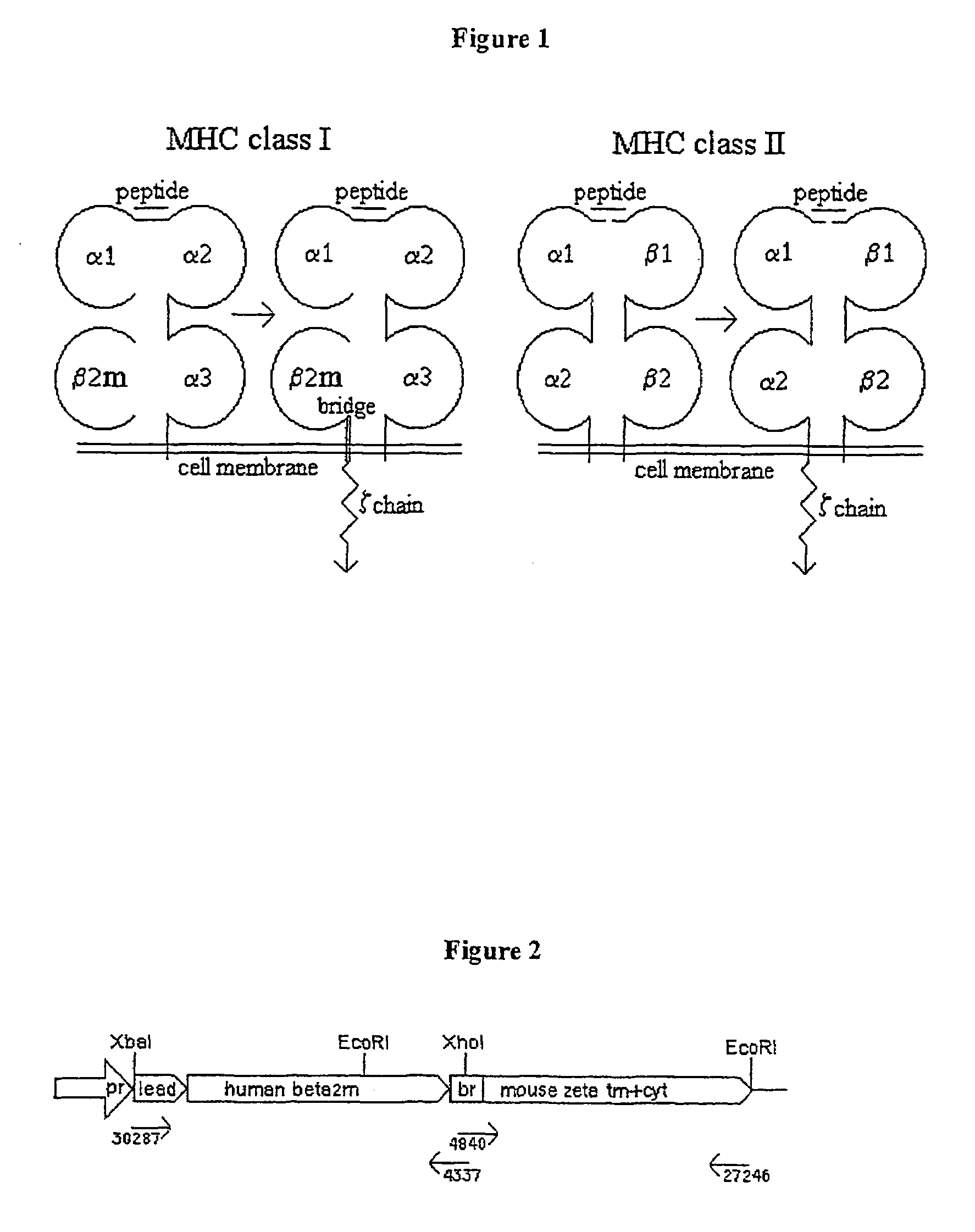Genetically-engineered MHC molecules
- Summary
- Abstract
- Description
- Claims
- Application Information
AI Technical Summary
Benefits of technology
Problems solved by technology
Method used
Image
Examples
example 1
Design of an MHC Class I Model System
[0082]In order to examine the feasibility of the conception of the invention, a class I MHC murine model system was mounted according to the general scheme presented in FIG. 1. As the MHC component, monomorphic human β2m was chosen. It associates with all class I heavy chains, thus allowing universality of use, both experimentally and therapeutically. As the signaling domain, the transmembranal and cytoplasmic portions of the mouse CD3 ζ chain was chosen.
[0083]As the effector cells we used MD45 cells, a CD8− H-2b-alloreactive H-2d / k mouse CTL hybridoma (Kaufmann, et al., 1981). These cells grow readily in culture, are highly transfectable and secrete considerable amount of cytokines following activation. Their lytic capacity is, however, partially compromised, compared with primary CTLs. It was chosen to work with human rather than mouse β2m in these cells, as it provides a distinct marker for the product of the chimeric gene. Human β2m is known ...
example 2
Class I MHC Construct Containing hβ2m
[0085]Human β2m (hβ2m) cDNA was cloned by RT-PCR, using mRNA prepared from Jurkat (human T cell leukemia) cells, with the following primers:
[0086]
1st strand primer, 4337, containing an XhoI restriction site:5′ G CTG GCT CGA GGG CTC CCA TCT CAG CAT GTC TCG ATC CCA CTT 3′(SEQ ID NO:10)2nd strand primer, 30287, containing an XbaI site:5′ GGG TCT AGA GCC GAG ATG TCT CGC TCC GTG 3′(SEQ ID NO:11)
[0087]A cDNA segment encoding the transmembranal and cytoplasmic regions of the murine CD3 ζ chain was cloned by RT-PCR from mRNA of MD45 cells with the following primers:
[0088]
1st strand primer, 27246, containing an EcoRI site:5′ GCG GAA TTC TTA GCG AGG GGC CAG GGT 3′(SEQ ID NO:12)2nd strand primer, 4840, containing an XhoI site:5′ GAG CCC TCG AGC CAG CCC ACC ATC CCC ATC CTC TGC TAC TTG CTA GAT 3′(SEQ ID NO:13)
[0089]While associated with the class I heavy chain HLA-A2, the distance of the C terminus of hβ2m from the cell membrane is equivalent to that occupied...
example 3
Construction of a Reporter System
[0096]Specific interactions between engineered effector cells and target T cells is expected to result in cytokine release by both parties. If both are of mouse origin, the source of the detected cytokines will be ambiguous. It was chosen to tackle this problem by co-transfecting the MD45 cells with plasmid 21-2 obtained in Example 2 above and with a genetic construct encoding the lacZ reporter gene driven by the minimal promoter of the human IL-2 gene [NF-AT-LacZ, kindly provided by Dr. N. Shastri, University of California (Karttunen et al., 1991)]. This was transfection 412. In addition, MD45 cells were co-transfected with the NF-AT-lacZ reporter gene and the pBJ1-Neo vector (transfection 392). For preliminary screening, G418-resistant clones were incubated with the T-cell mitogen Con A, and IL-2 gene activation was evaluated by the colorimetric ONPG assay, which monitors β-Gal activity. ONPG detection assay was again used with the strongest clones...
PUM
| Property | Measurement | Unit |
|---|---|---|
| Fraction | aaaaa | aaaaa |
| Fraction | aaaaa | aaaaa |
| Cytotoxicity | aaaaa | aaaaa |
Abstract
Description
Claims
Application Information
 Login to View More
Login to View More - R&D
- Intellectual Property
- Life Sciences
- Materials
- Tech Scout
- Unparalleled Data Quality
- Higher Quality Content
- 60% Fewer Hallucinations
Browse by: Latest US Patents, China's latest patents, Technical Efficacy Thesaurus, Application Domain, Technology Topic, Popular Technical Reports.
© 2025 PatSnap. All rights reserved.Legal|Privacy policy|Modern Slavery Act Transparency Statement|Sitemap|About US| Contact US: help@patsnap.com



